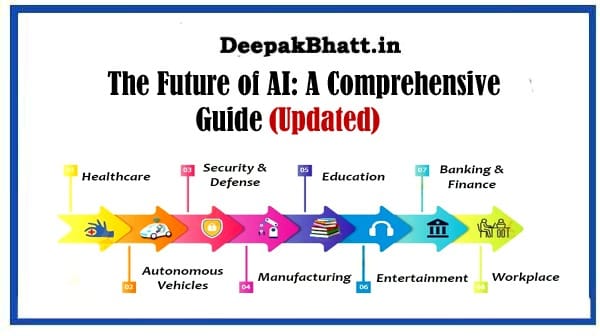Future of AI – Artificial Intelligence refers to the development of computer systems capable of performing tasks that typically require human intelligence.
- 1 Future of AI
- 1.1 Definition of Artificial Intelligence:
- 1.2 Key Features of Artificial Intelligence:
- 1.3 Types of Artificial Intelligence:
- 1.4 Examples of Artificial Intelligence Applications:
- 1.5 Frequently Asked Questions (FAQ) about Artificial Intelligence:
- 1.6 1. What is the difference between AI and Machine Learning?
- 1.7 2. Can AI replace human jobs?
- 1.8 3. How is AI regulated?
- 1.9 4. What are the ethical concerns with AI?
- 1.10 5. Are there limitations to AI?
- 1.11 Conclusion:
Future of AI
These tasks include learning, reasoning, problem-solving, perception, language understanding, and decision-making. Future of AI
Navigating Number Systems: Converting Octal
How to Improve Your Writing Skills Free Guide
Marketing Psychology: How To Become A Master Of Influence
TikTok Marketing: Grow Your Account & Master TikTok
Definition of Artificial Intelligence:
Artificial Intelligence can be defined as the simulation of human intelligence in machines programmed to think and mimic human actions. Future of AI It involves the creation of algorithms that allow computers to perform tasks intelligently without explicit programming.
Key Features of Artificial Intelligence:
- Learning Capability: AI systems can learn from data, improving their performance over time.
- Reasoning and Problem-Solving: AI can analyze information, conclude, and solve complex problems.
- Adaptability:AI systems can adapt to changing environments and evolving data.
- Natural Language Processing:Understanding and generating human language is a crucial AI feature.
- Perception and Sensing:AI can interpret and respond to sensory inputs, such as image recognition.
Types of Artificial Intelligence:
- Narrow AI (Weak AI):Designed for specific tasks; lacks the broad learning and reasoning abilities of humans.
- General AI (Strong AI):Possesses human-like cognitive abilities, allowing it to perform any intellectual task.
- Machine Learning:AI systems that can learn from data and improve their performance.
- Deep Learning:Subset of machine learning using neural networks to simulate human brain functions.
- Reinforcement Learning:Learning through trial and error, receiving rewards for correct actions.
Examples of Artificial Intelligence Applications:
- Chatbots and Virtual Assistants: Examples include Siri, Google Assistant, and customer service chatbots.
- Image and Speech Recognition: Facial recognition systems, voice-to-text applications, and image analysis.
- Recommendation Systems: Netflix and Amazon use AI to suggest movies and products based on user preferences.
- Autonomous Vehicles: Self-driving cars use AI for navigation, obstacle detection, and decision-making.
- Healthcare Diagnostics: AI assists in medical image analysis and disease diagnosis.
Frequently Asked Questions (FAQ) about Artificial Intelligence:
1. What is the difference between AI and Machine Learning?
AI is a broader concept, while machine learning is a subset of AI that focuses on the development of algorithms allowing systems to learn and make predictions.
2. Can AI replace human jobs?
While AI may automate certain tasks, it is more likely to augment human capabilities, creating new job opportunities and transforming existing roles.
3. How is AI regulated?
Regulations vary globally. Governments and organizations are developing ethical guidelines and policies to ensure responsible AI development and deployment.
4. What are the ethical concerns with AI?
Ethical concerns include bias in algorithms, data privacy, job displacement, and the potential misuse of AI for malicious purposes.
5. Are there limitations to AI?
Yes, limitations include the lack of true understanding, the need for large datasets, potential biases, and challenges in handling ambiguous or unpredictable situations.
Conclusion:
Artificial Intelligence, with its learning capabilities, problem-solving skills, and adaptability, is revolutionizing various industries.
From narrow AI applications like virtual assistants to the potential of achieving general AI, the field continues to advance.
While embracing the benefits, it is essential to address ethical concerns, regulations, and the potential impact on jobs.

















